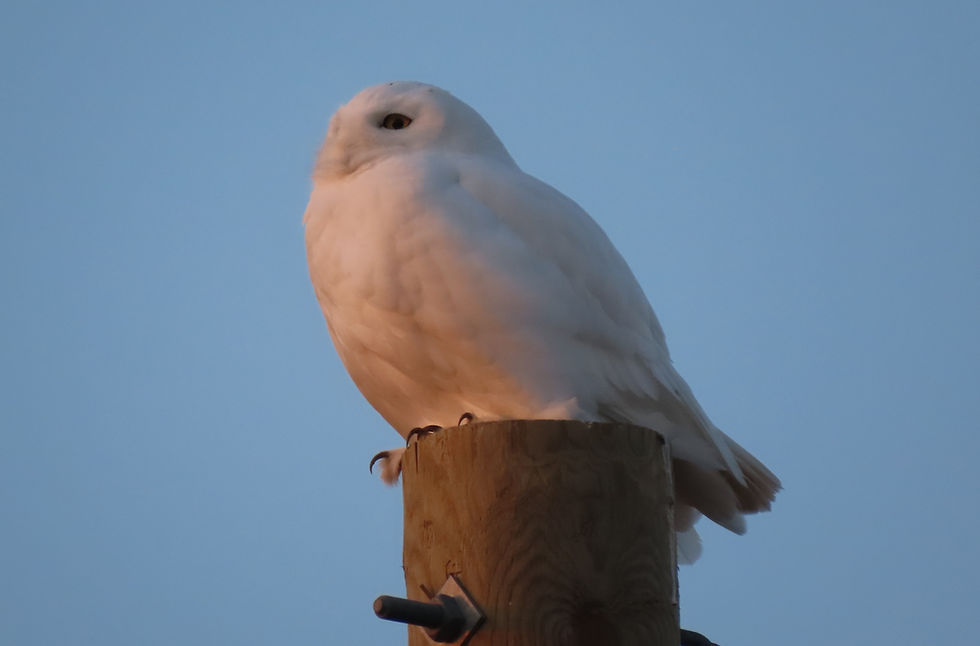So you want to see a Snowy Owl
- Paul Nicholson

- Dec 16, 2021
- 3 min read
This article has been reposted from its original publication in The Cardinal by Nature London with permission from the author.

The almost pure white plumage of this bird tells us that it is an adult male Snowy Owl. While overwintering in the London area and elsewhere across Southwestern Ontario, this species prefers treeless areas and will perch on a fence post or other rise to watch and listen for prey. Photo by Paul Nicholson.
Long before Harry Potter’s Hedwig, Snowy Owls have impressed people. They can still stop traffic and even turn the heads of muggles or non-birders.
The London area is fortunate every year to host snowy owls. Unlike Hedwig who hailed from the Eeylops Owl Emporium, non-fictional Snowies migrate south each December from their breeding grounds of the high Artic archipelago. Most fly back north early each spring. The allaboutbirds.org website suggests that half of the global population of these impressive birds spend at least part of the year in Canada.
Because the landscape in their northern habitat is flat, snowy, and treeless, their preferred habitat where they overwinter is similar. Although not unheard of, it would be highly unusual to find one of these birds perched in a tree in the middle of a forest.
This is close to the southern limit of their usual winter range. From time to time there will be an irruptive year with much greater than usual populations of Snowies. In that case, the surge in demand for their food will outstrip supply, causing the winter range to expand further south.
A Snowy Owl is approximately 60 cm in length, and at 1.8 kg, Snowies are by far our heaviest owl species. As a rule, these birds are solitary. Although they are generally nocturnal, while here in the south they will hunt during the day as needed.
Adult male birds are almost completely white with yellow eyes. The plumage of both females and young males has dark markings on otherwise white plumage. Females are larger than males.
Theses birds will sit in the same spot for long periods of time to conserve energy. When scanning for these birds, I check any big white spot that catches my eye. If it turns out to be a plastic bag or a lump of snow in a field or even just a sign, I feel no shame.
The best bet for seeing a Snowy Owl is on open country fields or airfields. They like to perch on a rise so that they can watch and listen for the small mammals that they typically dine on. I always have one eye on telephone poles, fence posts, the corners of a building, shrubs, or even the rise in the middle of a field.
A number of open fields around the London area are hot spots. Check north-west of Strathroy. There is a square defined by Egremont Dr., Seed Rd., Cuddy Dr., and School Rd. that historically has been productive for Snowy Owl sightings.
North of London you might have success on Roman Line or Fallon Dr. and Breen Dr. where they cross Roman Line.
The concession roads south of the city can also be productive. Each winter I will usually have Snowy sightings on Manning Dr. or other concession roads that cross Wellington Rd. S.
For detailed information about current local and regional sightings, the best resource is eBird Canada. And as with every other bird sighting, it is important that we respect and not harass the birds, and that we respect private property and otherwise observe the code of birders’ ethics.
Historically, Snowy Owls have been especially important to the Inupiat people of northern Alaska. In the Inuit languages of Inuktitut and Iñupiaq, the word for snowy owl is ukpik. Older readers will remember the Ookpik as the mascot of Montreal’s Expo 67, so J.K. Rowling wasn’t the first to popularize these magnificent birds. She certainly won’t be the last.




Comments